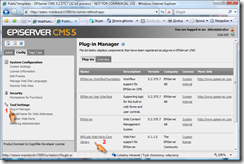The problem that can make a grown up man cry?
You?re editing your EPiServer 4 project and suddenly the edit mode stops working. the server reports compilation errors. something along the lines:
Compiler error: CS0433: Type ?EPiServer.Global? exists in ?c:\WINDOWS\assembly\GAC_MSIL\EPiServer\5.1.422.122__8fe83dea738b45b7\EPiServer.dll? and ?c:\WINDOWS\assembly\GAC\EPiServer\4.61.5.83__8fe83dea738b45b7\EPiServer.dll?
The solution is to go to your web.config and edit the compilation section. The section will most probably look something like this:
<configuration>
<system.web>
<compilation defaultLanguage="c#" debug="true">
<assemblies>
<add assembly="System.Web.Extensions, Version=1.0.61025.0, Culture=neutral, PublicKeyToken=31BF3856AD364E35"/>
<add assembly="System.Design, Version=2.0.0.0, Culture=neutral, PublicKeyToken=B03F5F7F11D50A3A"/>
<add assembly="System.Web.Extensions.Design, Version=1.0.61025.0, Culture=neutral, PublicKeyToken=31BF3856AD364E35"/>
<add assembly="EPiServer, Version=5.1.422.122, Culture=neutral, PublicKeyToken=8FE83DEA738B45B7"/>
<add assembly="Microsoft.Web.Services3, Version=3.0.0.0, Culture=neutral, PublicKeyToken=31BF3856AD364E35"/>
<add assembly="EPiServer.BaseLibrary, Version=5.1.422.122, Culture=neutral, PublicKeyToken=8FE83DEA738B45B7"/>
<add assembly="System.Configuration.Install, Version=2.0.0.0, Culture=neutral, PublicKeyToken=B03F5F7F11D50A3A"/>
<add assembly="EPiServer.Configuration, Version=5.1.422.122, Culture=neutral, PublicKeyToken=8FE83DEA738B45B7"/>
<add assembly="EPiServer.Implementation, Version=5.1.422.122, Culture=neutral, PublicKeyToken=8FE83DEA738B45B7"/>
<add assembly="EPiServer.XForms, Version=5.1.422.122, Culture=neutral, PublicKeyToken=8FE83DEA738B45B7"/>
<add assembly="EPiServer.Events, Version=5.1.422.122, Culture=neutral, PublicKeyToken=8FE83DEA738B45B7"/>
<add assembly="EPiServer.Lucene, Version=5.1.422.122, Culture=neutral, PublicKeyToken=8FE83DEA738B45B7"/>
<add assembly="ElektroPost.Licensing, Version=5.1.422.122, Culture=neutral, PublicKeyToken=8FE83DEA738B45B7"/>
<add assembly="System.Data.OracleClient, Version=2.0.0.0, Culture=neutral, PublicKeyToken=B77A5C561934E089"/>
<add assembly="EPiServer.Wsrp, Version=5.1.422.122, Culture=neutral, PublicKeyToken=8FE83DEA738B45B7"/>
<add assembly="EPiServer.WebParts, Version=5.1.422.122, Culture=neutral, PublicKeyToken=8FE83DEA738B45B7"/>
<add assembly="EPiServer.UI, Version=5.1.422.122, Culture=neutral, PublicKeyToken=8FE83DEA738B45B7"/>
<add assembly="EPiServer.Web.WebControls, Version=5.1.422.122, Culture=neutral, PublicKeyToken=8FE83DEA738B45B7"/>
</assemblies>
</compilation>
</system.web>
</configuration>
in my case only the 4th line referencing the EPiServer.dll was interfering with the editing working, but this can easily be trimmed to only first 3 options, so once you’re done with removing CMS5 entries it could look something like:
<configuration>
<system.web>
<compilation defaultLanguage="c#" debug="true">
<assemblies>
<add assembly="System.Web.Extensions, Version=1.0.61025.0, Culture=neutral, PublicKeyToken=31BF3856AD364E35"/>
<add assembly="System.Design, Version=2.0.0.0, Culture=neutral, PublicKeyToken=B03F5F7F11D50A3A"/>
<add assembly="System.Web.Extensions.Design, Version=1.0.61025.0, Culture=neutral, PublicKeyToken=31BF3856AD364E35"/>
</assemblies>
</compilation>
</system.web>
</configuration>
The root of the problem supposedly lies in EPiServer SDK integrated with Visual Studio and it?s Visual Studio that puts those lines there once you attempt to add a new element with one of its toolbars or use the Insert->New item? from File menu or context menu in Project Explorer.
Thanks to the guys on #epicode IRC channel for helping out quickly with the problem.











